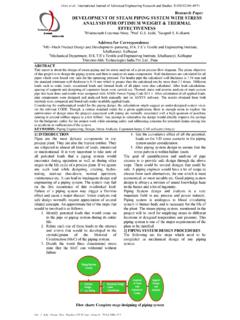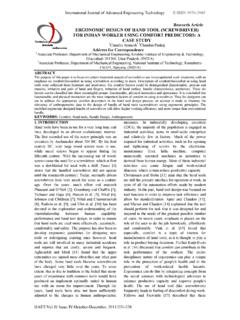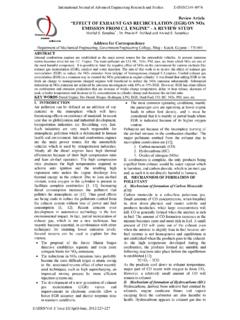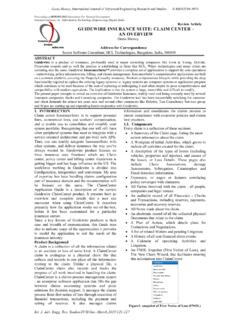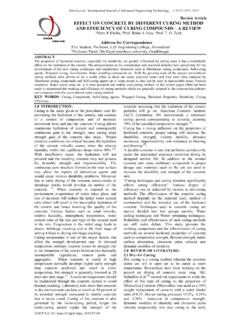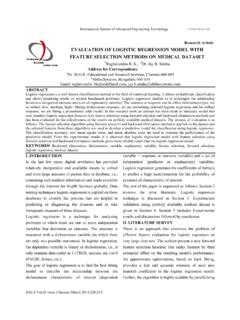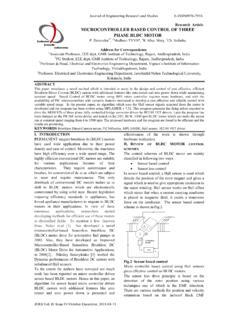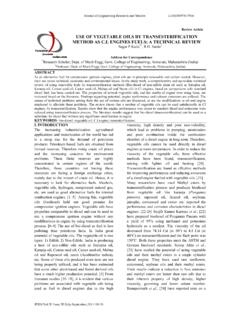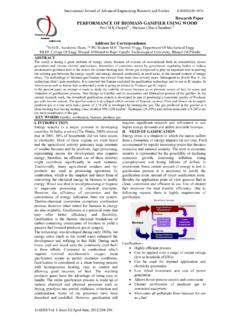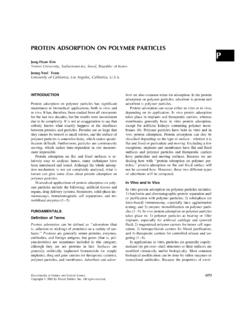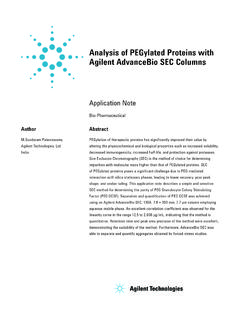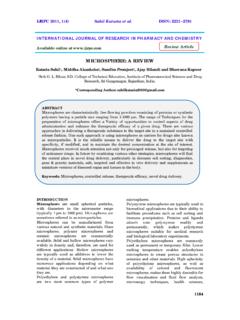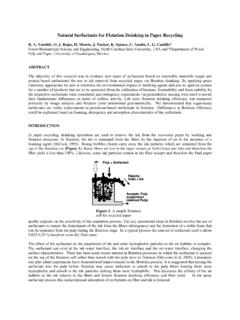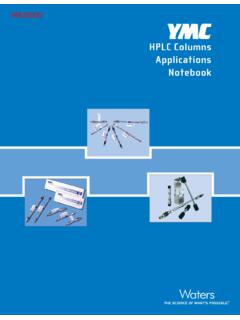Transcription of Research Article APPLICATION OF PLANT BASED …
1 International Journal of Advanced Engineering Research and Studies E-ISSN2249 8974. Research Article APPLICATION OF PLANT BASED COAGULANTS FOR. WASTE WATER TREATMENT. G. Vijayaraghavan*, T. Sivakumar*, A. Vimal Kumar**. Address for Correspondence * Assistant Professor, Chemical Engineering, Adhiparasakthi Engineering College, Melmaruvathur ** Assistant Professor, Chemical Engineering, Arunai Engineering College, Thiruvannamalai ABSTRACT. A review of PLANT - BASED coagulant sources, processes, effectiveness and relevant coagulating mechanisms for treatment of water and wastewater is presented. These coagulants are, in general, used as point-of-use technology in less-developed communities since they are relatively cost-effective compared to chemical coagulants, can be easily processed in usable form and biodegradable.
2 These natural coagulants, when used for treatment of waters with low-to-medium turbidity range (50 . 500 NTU), are comparable to their chemical counterparts in terms of treatment efficiency. Their APPLICATION for industrial wastewater treatment is still at their infancy, though they are technically promising as coagulant for dyeing effluent as afforded by Yoshida intermolecular interactions. These natural coagulants function by means of adsorption mechanism followed by charge neutralization or polymeric bridging effect. Frequently studied PLANT - BASED coagulants include Nirmali seeds (Strychnos potatorum), Moringa oleifera, Tannin and Cactus. Utilization of these coagulants represents important progress in sustainable environmental technology as they are renewable resources and their APPLICATION is directly related to the improvement of quality of life for underdeveloped communities.
3 KEYWORDS Natural coagulant, PLANT BASED coagulant, Waste water treatment 1. INTRODUCTION the treatment of both surface water and industrial The production of drinking water from most raw wastewater. Its APPLICATION includes removal of water sources involves coagulant use at a dissolved chemi-cal species and turbidity from water coagulation/flocculation stage to remove turbidity in via addition of conventional chemical- BASED the form of suspended and colloidal material. Many coagulants, namely, alum (AlCl3), ferric chloride coagulants and flocculants are widely used in (FeCl3) and polyaluminium chloride (PAC) [4]. conventional water treatment processes. These While the effectiveness of these chemicals as materials can be classified into inorganic coagulants coagulants is well-recognized, there are, nonetheless, ( aluminium and ferric salts) and synthetic disadvantages associated with usage of these organic polymers ( polyacryl amide derivatives coagulants such as ineffectiveness in low-temperature and polyethylene imine).
4 Aluminium salts are cheap water, relatively high procurement costs, detrimental and are the most widely used coagulants in water and effects on human health, production of large sludge wastewater treatment all over the world. Regarding volumes and the fact that they significantly affect pH. the APPLICATION of synthetic polymers, the presence of of treated water. There is also strong evidence linking residual monomers is undesirable because of their aluminium- BASED coagulants to the development of neurotoxicity and strong carcinogenic properties. In Alzheimer's disease in human beings. It is therefore recent years there has been considerable interest in desirable to replace these chemical coagulants with the development of usage of natural coagulants which PLANT - BASED coagulants to counteract the can be produced or extracted from microorganisms, aforementioned drawbacks.
5 Animal or PLANT tissues. These coagulants should be 3. MERITS OF PLANT - BASED COAGULANTS. biodegradable and are presumed to be safe for human The main advantages of using natural PLANT - BASED health. In addition, natural coagulants produce coagulants as POU water treatment material are readily biodegradable and less voluminous sludge apparent; they are cost-effective, unlikely to produce that amounts only 20 30% that of alum treated treated water with extreme pH and highly counterpart [3] . The use of natural materials of PLANT biodegradable. These advantages are especially origin to clarify turbid raw waters is not a new idea. augmented if the PLANT from which he coagulant is Natural coagulants have been used for domestic extracted is indigenous to a rural community. In the household for centuries in traditional water treatment age of climate change, depletion of earth's natural in tropical rural areas Nowadays, some reports resources and widespread environmental degradation, describe natural coagulants from Nirmali seed and APPLICATION of these coagulants is a vital effort in line maize mesquite bean and Cactus latifaria Cassia with the global sustainable development initiatives.
6 Angustifolia seed and different leguminose species. Usage of PLANT - BASED coagulants for turbid water Nevertheless, the material which has recently treatment dates back to over several millennia ago received the greatest degree of attention is the seed of and thus far, environmental scientists have been able Moringa oleifera indigenous to Sudan. The water to identify several PLANT types for this purpose. While extract of M. oleifera seeds compares quite it is understandable that the coagulants are meant as favourably with aluminium salt simple domestic POU technology, there have also 2. COAGULATION been numerous studies focused on their usage for Due to the lack of proper water treatment systems in treatment of industrial wastewaters. The mechanisms these rural or underdeveloped communities, the best associated with different natural coagulants are immediate option is to use simple and relatively cost- varied as well [1].
7 It is imperative for relevant effective point-of-use (POU) technologies such as stakeholders to fully comprehend the technicalities coagulation. Coagulation is an essential process in involved when considering the coagulants for rural, IJAERS/Vol. I/ Issue I/October-December, 2011/88-92. International Journal of Advanced Engineering Research and Studies E-ISSN2249 8974. domestic or industrial water treatment. To address discussion in the following sections. The existence of this, this paper provides an overview of the natural background electrolytes in aqueous medium can coagulant sources, processes and mechanisms facilitate the coagulating effect of polymeric involved so that environmental specialists can tailor coagulants since there is lesser electrostatic repulsion its usage for a myriad of water contaminants.
8 Between particles [5]. Although many PLANT - BASED To provide a more focused discussion, natural coagulants have been reported, only four types are coagulants derived from non- PLANT sources such as generally well-known within the scientific chitosan (widely produced from exoskeleton of community, namely, Nirmali seeds (Strychnos crustaceans) and isinglass (produced from fish swim potatorum), Moringa oleifera, Tannin and Cactus. bladders) are excluded from this review. This Nirmali Seeds exclusion is BASED on practicability, since non- PLANT S. potatorum (nirmali) is a moderate-sized tree found sources are less likely to have the potential for mass in Southern and central parts of India, Sri Lanka and production compared to PLANT sources [10]. It is Burma, used predominantly as a traditional medicinal surprising to note that a comprehensive critical extract.
9 Sanskrit writings from India reported that the analysis of available PLANT - BASED coagulants is still seeds were used to clarify turbid surface water over non-existent given the importance of sustainable 4000 years ago which indicated that they were the environmental technology in the 21st century and first reported PLANT - BASED coagulant used for water hopefully this review can provide an immediate treatment. Most studies concerning its use as platform for environmental scientists to intensify coagulant seem to be limited within the Indian their Research on these natural materials. subcontinent. Nirmali seed extracts are anionic 4. NATURAL PLANT - BASED COAGULANTS polyelectrolytes that destabilize particles in water by AND COAGULATION MECHANISMS means of interparticle bridging.
10 Previous studies have Polymeric coagulants can be cationic, anionic or established that the seed extracts also contain lipids, nonionic, in which the former two are collectively carbohydrates and alkaloids containing the COOH. termed as polyelectrolytes. Many studies concerning and free OH surface groups which enhance the natural coagulants referred to them as extracts' coagulation capability [11]. A mixture of polyelectrolytes' even though many of these studies polysaccharide fraction extracted from S. potatorum did not actually conduct in-depth chemical seeds contained galactomannan and galactan capable characterization to determine their ionic activity [2]. of reducing up to 80% turbidity of kaolin solution. In As such, this term should be used carefully, and be all cases, the galactomannans are made up of a main applied only after ionic activity is determined to be chain of 1,4-linked d-mannopyranosyl residues present in the coagulant.
